
Posted on 07/14/2011 4:48:34 AM PDT by Homer_J_Simpson

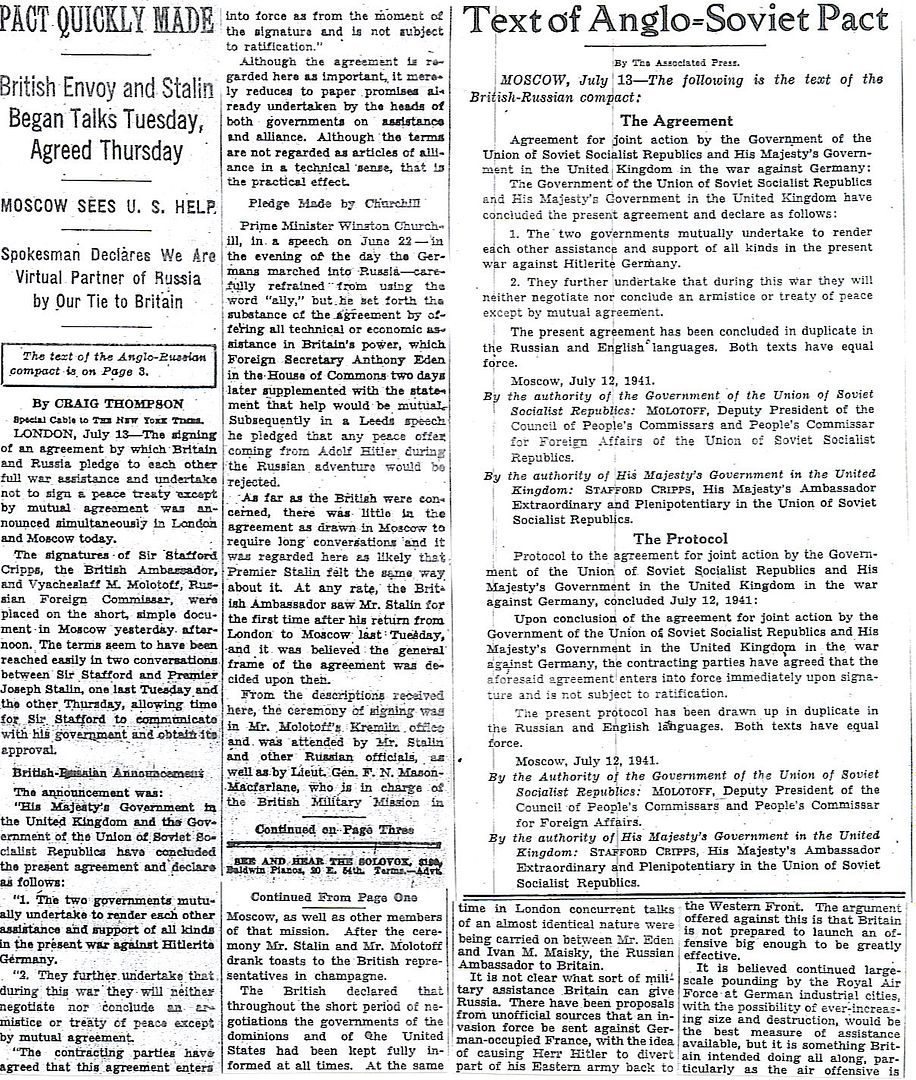
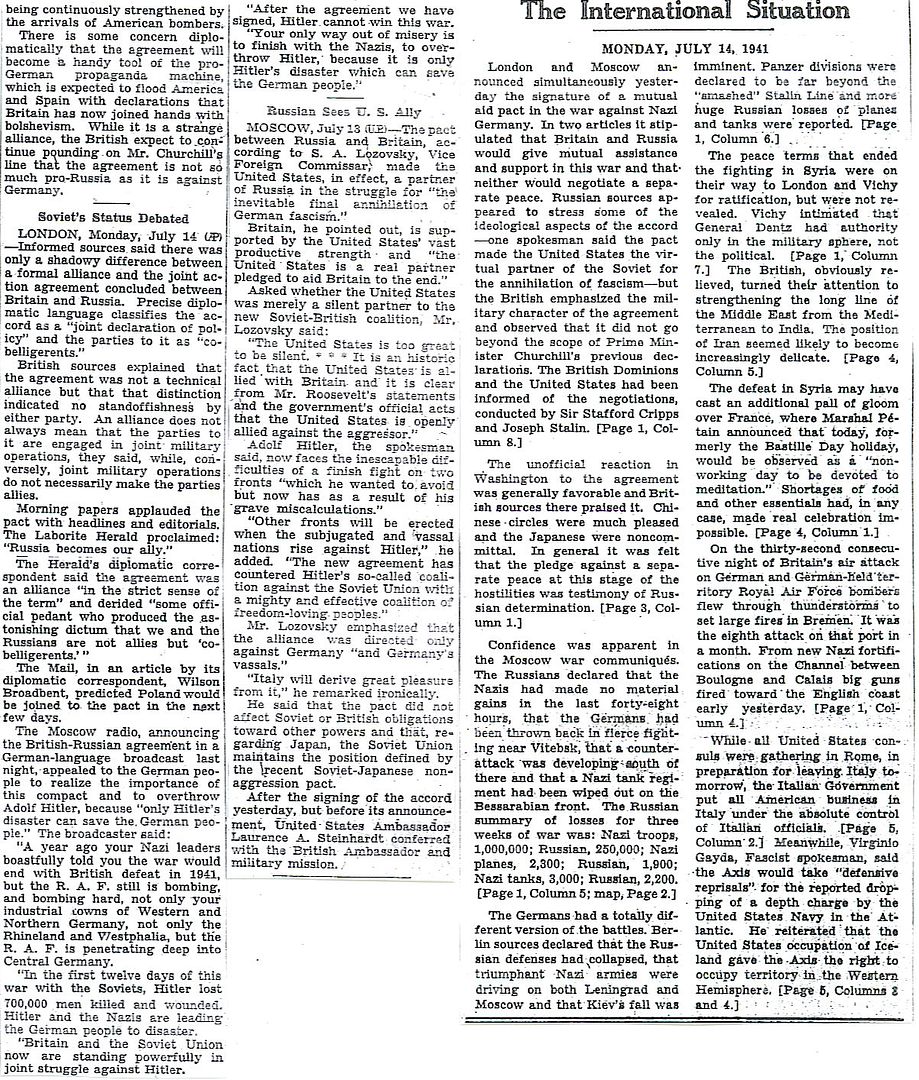

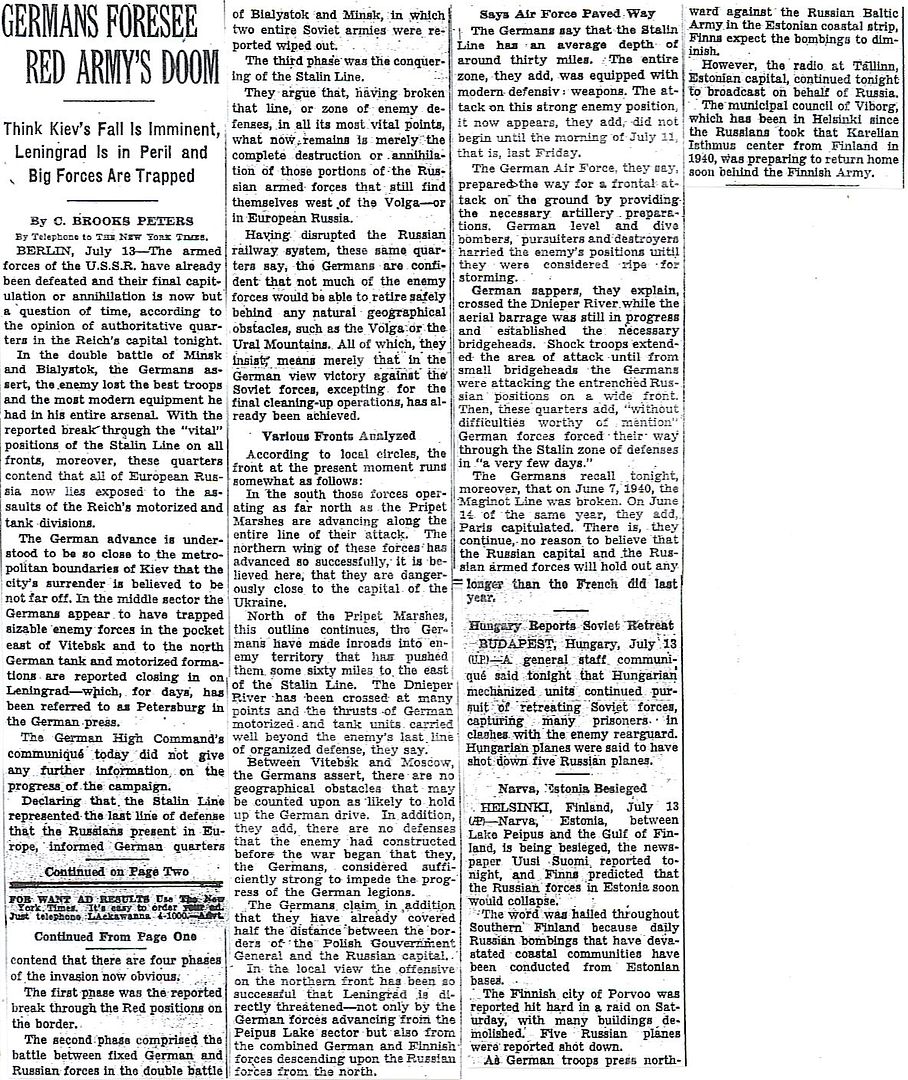


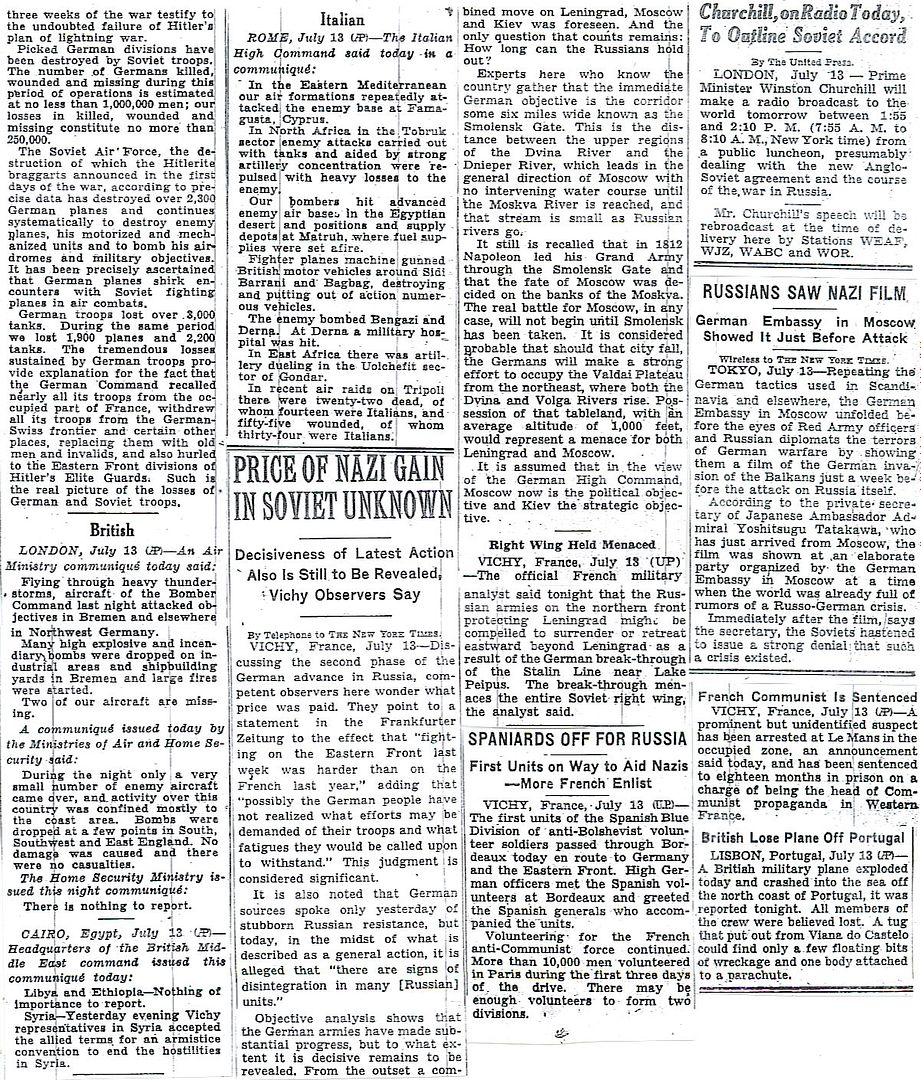
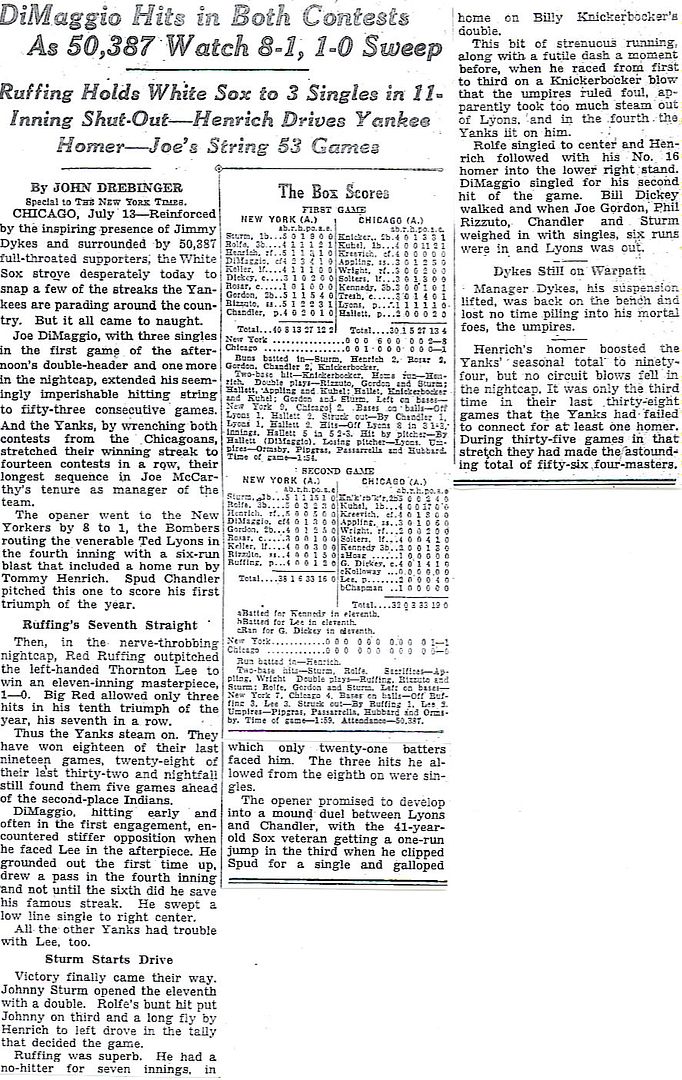
http://www.onwar.com/chrono/1941/jul41/f14jul41.htm
Soviets introduce katyusha rockets
Monday, July 14, 1941 www.onwar.com
On the Eastern Front... The German advance continues and the Luga River is reached in the northern front. Meanwhile, near Orsha, Red Army artillery forces launch a salvo of katyusha rockets, for the first time, against the German held railhead causing substantial damage and panick.
In the Mediterranean... A force of German Ju88 bombers attacks Suez from bases in Crete causing damage to harbor installations and to ships unloading.
http://homepage.ntlworld.com/andrew.etherington/month/thismonth/14.htm
July 14th, 1941
UNITED KINGDOM: RAF Bomber Command: 2 Group: Blenheims raid Le Havre at low-level. Considerable damage is done to dock installations, but there are few ships in harbour. Two aircraft are lost to fighters.
Submarine HMS Simoon laid down.
ASW trawler HMS Quadrille commissioned. (Dave Shirlaw)
U.S.S.R.: German troops reach the river Luga and now threaten Leningrad directly.
Oberst Erhard Raus’s grenadiers, aided by an attached group of “Brandenburg” special-operation troops driving captured Soviet trucks and dressed in Russian Army uniforms, siezed the twin bridges over the Luga River at Porechye on 14 July,1941 - thus fording the last natural obstacle to Heeresgruppe Nord’s ultimate goal of the capture of Leningrad. (Russ Folsom)
Smolensk: The Katyusha mobile rocket-launcher is used in action for the first time.
SYRIA: Saint Jean d’Acre: The armistice terms are announced. The Vichy troops would be granted ‘full honours of war’, and even allowed to retain their personal arms; they would be concentrated under their leaders, and those who did not wish to join the Allied corps would be repatriated by units - thus rendering any free choice almost impossible; their equipment would be handed over to the British only; moreover, the Special Troops of the Levant, made up of Syrian and Lebanese volunteers, would purely and simply be placed under British command; there was no reference at all to Free France.
MEDITERRANEAN SEA: Ju-88 bombers attack Suez from Crete damaging harbour installations and ships.
U.S.A.: Submarine USS Herring laid down. (Dave Shirlaw)
Baseball, the Chicago White Sox and the New York Yankees play a single game in Comisky Park, Chicago, Illinois. Yankee star Joe DiMaggio hits a single off White Sox pitcher Johnny Rigney and extends his hitting streak to 54 consecutive games. (Jack McKillop)
The extremely heavy defensive fighting in which the German units were engaged testified to the seriousness of the situation. However, Timoshenko's plan miscarried.
The credit for this must go above all to 1st Cavalry Division, under General Feldt, which hurled itself against Timoshenko's attacks. Together with 10th Motorized Infantry Division and parts of 4th Panzer Division, this cavalry division covered the flank of Second Panzer Group.
This crucial action by the 1st Cavalry Division deserves special mention.
The only major German cavalry unit in the Second World War until 1944, Major-General Feldt's cavalry brigades operated along the fringe of the impassable Pripet Marshes, on ground not negotiable by the tanks. The roads were no more than bridle-paths, and shrubs and moorland provided an ideal terrain for enemy ambushes and traps. The 1st Cavalry Division acquitted itself exceedingly well on this ground, protected Guderian's flank, and efficiently maintained contact with the units of Rundstedt's Army Group operating south of the great marshes. It was the successful repulse of all attacks against his flank that enabled Guderian to strike towards Smolensk.
Blow now followed blow.
In the evening of 15th July the 7th Panzer Division, which was part of Colonel-General Hoth's Third Panzer Group, drove past Smolensk to the north, with strong Luftwaffe support, and cut both the motor highway and the railway-line from Smolensk to Moscow. The town was thus cut off from supplies and reinforcements, and a new pocket had been formed with 15 Soviet divisions in it.
The Soviet High Command wanted to hold Smolensk at all costs. Smolensk was something rather like Stalingrad—a symbol as well as a vital strategic position. Smolensk was the key to the gates of Moscow, a fortress on the upper Dnieper, one of the most ancient Russian settlements. It was here that, on 16th and 17th August 1812, Napoleon won the victory which enabled him to march to Moscow. It was here that exactly three months later, on 16th and 17th November 1812, the Tsarist General Kutuzov defeated France's Grand Armée. This explains the emotional intensity with which Smolensk was defended.
The men of General von Boltenstern's 29th Motorized Infantry Division were to encounter it very soon.
Those were days which the 71st and 15th Regiments, the 29th Artillery Regiment, the engineers, and the Motorcycle Battalion, above all 2nd Company, under Second Lieutenant Henz, who throughout six days hung on to the Dnieper bridge east of the town after it had been taken by a surprise attack, would never forget.
According to General Yeremenko's report the commandant of the Smolensk garrison had been ordered to practice 'total defence.' The streets were barricaded, and concrete pill-boxes had been set up. Every house, every cellar was a center of resistance. Workers and clerks had been armed and, with units of the State police and militia, had been organized into street fighting detachments. They had orders to hold their blocks of buildings or die. The military backbone of the city's defense was provided by the rifle regiments of the Soviet XXXIV Rifle Corps.
Nevertheless Smolensk fell.
What was more, it fell quickly. The defense was no match for the bold and cunning assault by the Thuringian 71st Infantry Regiment. In the morning of 15th July, at 0700 hours, Colonel Thomas went into action with his regiment. He circumvented the enemy lines by taking a farm track 9 miles south-west of the town. He attacked from the south. At 1100 his 2nd Battalion stormed the heavy Russian batteries on the hills of Konyukhovo. Prisoners reported that the southern exit from the town was also heavily fortified. Thomas therefore wheeled his regiment once more to the right and attacked the town from the south-east. When the defenders spotted the German spearheads at 1700 hours it was too late.
By nightfall assault detachments of the 71st Regiment were already in the streets of the southern suburbs.
On the following morning at 0400 the main attack was launched jointly with 15th Infantry Regiment. Heavy artillery, 8.8 cm. AA guns, mortars, self-propelled guns, and flame-throwing tanks cleared the way for the infantry. In the northern part of the town, in the industrial suburbs, police and workers' militia units resisted stubbornly. Every house and every cellar had to be taken separately by pistol, hand-grenade, and bayonet. Towards 2000 hours on 16th July the troops reached the northern edge of the town.
Smolensk was in German hands.
Hitler Moves East by Paul Carell
BBC - General Charles DeGaulle Urges America to Join the Allies (Translation over speaker)
According to Marshall Andrei Yeremenko, the BM-13 Katyusha is not used in combat until tomorrow. I have an interesting quote on that I will be posting.

One of several Russians killed after taking shots at German supply convoys near Rawa-Ruska-June 30
Mapping out potential supply routes eastward into White Russia July-41
Summer evening in a Ukrainian village. German unit bivouacs in a Ukrainian village somewhere on the steppes north of Zhitomir. (July 1941)
Rest halt in a Ukrainian village July 1941
Russian weapons laying along the road in Ukraine (july 1941)
Toppled statue of Lenin in Lenin Plaza, Minsk (Aug 41)
Halt on a road to await transportation toward Smolensk area. Undated but likely mid-July 41
Photo is dated July 41 but contains no description.
German troops from a motorized unit relax while awaiting fuel for their vehicles. South of Gomel July 41
German unit passing small Ukraine village on the steppes.
Soviet brass negotiate the surrender of their units. Location of event appears to be deliberately censored although it was late July and had to be in the Ukraine.
Soviet partisans killed while trying to attach explosives to destroyed tank. Lepel July 41
I believe the 8th SS Division, FLORIAN GEYR, a cavalry division, was formed before 1944.
I believe you're right
Look at all that dust they are kicking up just by walking. No wonder their vehicles were quickly wearing out as well as their horses. If its not mud after a rain squall, it is wicked dusty.
A girl canoeing topless????
And then the all girl action scene in the ‘outdoor bath’
I thought the cold shower scene was going to be a good as it got this issue.
I really can’t offer any excuses for this one. Once it said “Mary is all wet” I couldn’t stop laughing. Then it got worse.
Disclaimer: Opinions posted on Free Republic are those of the individual posters and do not necessarily represent the opinion of Free Republic or its management. All materials posted herein are protected by copyright law and the exemption for fair use of copyrighted works.